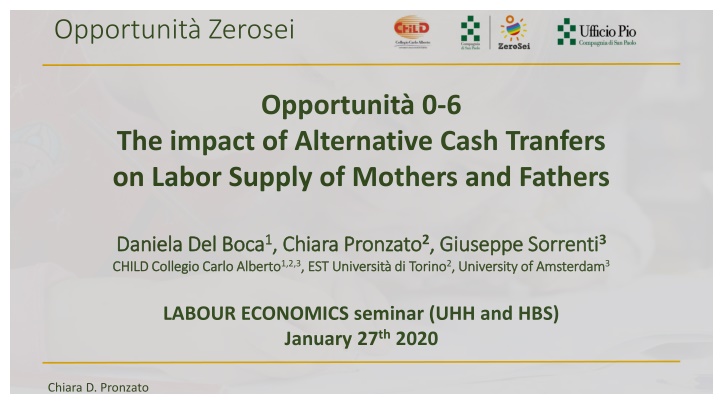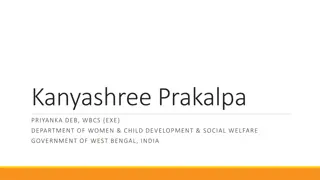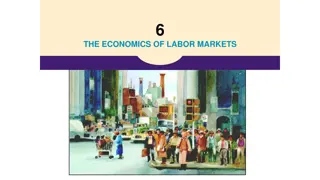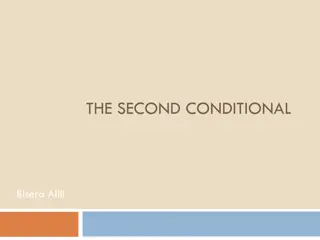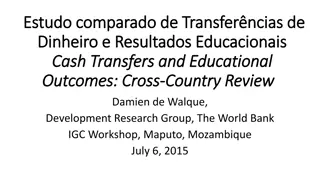Impact of Conditional Cash Transfers on Labor Supply in Disadvantaged Families
This project aims to assess the influence of a conditional cash transfer program on the labor supply of men and women in economically disadvantaged families with young children. By introducing conditionality to an existing unconditional cash transfer program, the study seeks to understand the effects on poverty reduction and productive behaviors in such households.
Download Presentation

Please find below an Image/Link to download the presentation.
The content on the website is provided AS IS for your information and personal use only. It may not be sold, licensed, or shared on other websites without obtaining consent from the author.If you encounter any issues during the download, it is possible that the publisher has removed the file from their server.
You are allowed to download the files provided on this website for personal or commercial use, subject to the condition that they are used lawfully. All files are the property of their respective owners.
The content on the website is provided AS IS for your information and personal use only. It may not be sold, licensed, or shared on other websites without obtaining consent from the author.
E N D
Presentation Transcript
Opportunit Zerosei Opportunit 0-6 The impact of Alternative Cash Tranfers on Labor Supply of Mothers and Fathers Daniela Del Boca Daniela Del Boca1 1, Chiara Pronzato CHILD CHILD Collegio Collegio Carlo Alberto Carlo Alberto1,2,3, EST , Chiara Pronzato2, Giuseppe Sorrenti , Giuseppe Sorrenti3 , EST Universit Universit di Torino di Torino2, University of Amsterdam , University of Amsterdam3 LABOUR ECONOMICS seminar (UHH and HBS) January 27th2020 Chiara D. Pronzato
Aim of the project To evaluate the impact of a conditional cash transfer (CCT) program on labour supply of men and women in families characterized by Severe economic disadvantage Presence of young children Specifically, to evaluate the introduction of conditionality into a pre-existing unconditional cash transfer program (UCT) Chiara D. Pronzato 2/28
Motivation Motivation In the last few decades, the majority of programs targeted to reduce poverty have taken the form of unconditional cash transfers Although these programs have helped to reduce poverty in low-income families in the short-term, their long-term effects are more mixed (Fernald, 2013) Recent literature has shown that a more effective way to reduce the persistence of poverty is to link income support to productive" behaviors, such as investments in human and physical capital Disadvantaged families are also often uninformed of the returns of these investments (Cunha et al., 2013) Chiara D. Pronzato 3/28
Previous work Previous work In lower- and middle-income countries, the conditions" potentially benefit the children in the household and usually involve education and health services (Attanasio et al., 2012; Attanasio et al., 2015; Behrman et al., 2011; Behrman et al., 2012) Fiszbein and Schady (2009), Baird et al. (2011), and Baird et al. (2014) show that the effectiveness of a particular CCT depends on several characteristics of the program design and the target groups CCT programs appear more effective in contexts in which school enrollment and health center attendance requirements are relatively low and where services are easily available and of higher quality (Saavedra and Garcia, 2017) CCT programs appear to have longer-term effects on educational and health outcomes than UCTs (Baez and Camacho, 2011; Macours et al., 2012) Chiara D. Pronzato 4/28
Previous work (2) Previous work (2) Only very recently have CCTs been implemented in high-income countries where the economic situation of families with children, especially minorities and immigrants, has worsened since the 2007 economic crisis In these contexts, where the large majority of families already use educational and health services, CCT programs are designed to provide more-accessible information concerning education and health services and their impacts on child outcomes to incentivize a better use of resources Family Rewards in New York City was the first CCT program to be implemented and evaluated in the United States. Designed for low-income families, to support children's educational efforts and achievements, family preventive health care practices, and parents employment (Aber and Rawlings, 2011; Miller et al., 2015) Chiara D. Pronzato 5/28
Contribution Contribution In this paper, we evaluate the impact of the CCT program Opportunity Zero-Six on household members' labor supply In the context of a high-income country, Italy, where the recent economic crises have worsened the conditions of families with children, especially among immigrants The design of our intervention, which was based on the expansion of an existing UCT program, allows us to compare two treatment groups, namely a group of families receiving only an unconditional cash transfer and a group of families receiving the cash transfer conditional on the attendance of mentoring courses Chiara D. Pronzato 6/28
Outline Outline The program The evaluation design The data collection The model The results Labour supply Mechanisms Financial wellbeing Heterogeneous effects Chiara D. Pronzato 7/28
The program The program The OpportunityZero-Six Intervention complemented the preexisting income support program Accoglienza Orientamento Supporto (AOS) AOS has been run in the metropolitan area of Turin and has supported about 1,000 families per year since 2008 The program is financed and managed by Ufficio Pio, a philanthropic institution based in Turin While AOS is a typical UCT, Opportunity Zero-Six conditions the provision of the income transfer on recipient's attending mentoring courses Chiara D. Pronzato 8/28
The program (2) The program (2) Admission to the program is based on two eligibility criteria The first is family income. The Equivalent Economic Situation (ISEE) needs to be below 7,000 The second eligibility criterion requires the family to have at least a child under the age of six Applications are accepted on a rolling basis, meaning that families can apply to the program at any time of the year Every two weeks, the Ufficio Pio establishes a ranking of families, and includes a fixed number of families in the program Families remain in the ranking until December Chiara D. Pronzato 9/28
The program (3) The program (3) The yearly cash transfer amounts to 2,500 There are four available mentoring courses, pairs of courses are assigned: Reconciliation of work and family + use of money At least one unemployed adult, difficulties in reconciling Job-seeking + parenting At least one unemployed, no difficulties in reconciling cited Parenting + use of money No unemployment Chiara D. Pronzato 10/28
The evaluation design The evaluation design In 2016, Ufficio Pio selected around 1,500 families (90 families for 16 times) and, through a randomization process, we assigned around 1,500 families to one of the three groups The CCT group: cash transfers conditional to the participation in the two courses around 500 families The UCT group: unconditional cash transfers around 500 families The control group: no transfers no courses (also for the 2017) around 500 families Chiara D. Pronzato 11/28
The timeline of the experiment The timeline of the experiment Chiara D. Pronzato 12/28
The courses The courses 93% of the families takes either the course in job-seeking or the course in work- family reconciliation We focus on these families and on their labour outcomes Each course was made by five two-hour meetings, or by four three-hour meetings Only one family member was required to participate in the meetings S/he can skip at most one meeting The course instructors was helped by translators assisting individuals with imperfect knowledge of the Italian language Chiara D. Pronzato 13/28
The courses (2) The courses (2) The course on job-seeking aims to enhance participants' labor market opportunities in two main ways First, the course has the objective to provide participants with information on how to find suitable job opportunities Second, the course aims to improve participants' labor market opportunities by fostering their ability to recognize and evaluate own individual skills and competencies Chiara D. Pronzato 14/28
The courses (3) The courses (3) The course on work-family reconciliation aims to provide families with useful information on how to reconcile work and family tasks The idea is to provide participants with basic information on services offered by the city, e.g. formal childcare, potentially reducing time devoted to family tasks And to make them think how to construct a network of parents and friends in case of (reciprocal) need At the same time, participants are given information on how to find suitable job opportunities, how to write their CV, Chiara D. Pronzato 15/28
The interview The interview The survey was administered twelve months after the family was admitted to the program or was assigned to the CG Families were interviewed at home or at a public place of their choice The mother of the youngest child was chosen as the respondent Families in the control group were offered a 100 voucher as an incentive Chiara D. Pronzato 16/28
The data The data The survey covers several areas potentially affected by the cash transfer and by the information included in the courses The main area covered by the survey is about family members' labor supply, and job seeking activities Others areas covered by the survey are related with social inclusion, financial problems, nutrition, children's schooling Chiara D. Pronzato 17/28
The randomization process The randomization process CCT UCT CG In a couple 0.71 0.67 0.70 Mother s age 35 35 35 Father s age 42 42 41 No citizenship 0.71 0.73 0.70 Number of children 2.1 2.2 2.1 Age of the youngest 2.9 3.0 2.9 Mother secondary 0.40 0.39 0.39 Mother Italian edu 0.35 0.38 0.33 Father secondary 0.42 0.42 0.39 Father Italian edu 0.25 0.30 0.30 Couple, both work 0.01 0.01 0.00 Couple, one works 0.48 0.45 0.46 Couple, no work 0.51 0.54 0.53 Single, work 0.14 0.14 0.16 ISEE 883 894 935 Obs 503 500 478 Chiara D. Pronzato 18/28
The final sample The final sample CCT UCT CG In a couple 0.70 0.68 0.68 No different probabilities of participating in the survey for families in the three groups Mother s age 35 35 35 Father s age 42 41 41 No citizenship 0.75 0.74 0.71 Number of children 2.0 2.1 2.1 Age of the youngest 2.9 3.2 2.9 Immigrants participate significantly more Mother secondary 0.41 0.39 0.38 Mother Italian edu 0.35 0.38 0.33 Father secondary 0.41 0.41 0.39 Father Italian edu 0.24* 0.30 0.31 Couple, both work 0.01 0.01 0.00 Couple, one works 0.48 0.48 0.46 Couple, no work 0.51 0.51 0.54 Single, work 0.17 0.15 0.15 ISEE 833 897 913 Obs 350 370 351 Chiara D. Pronzato 19/28
The model The model Linear probability model, with robust standard errors To improve estimates precision, we include in the model information on family income (ISEE), number of household members under age 18, secondary education, and an indicator for respondent with Italian citizenship Finally, to take into account the rolling basis application process and the possible effect induced by each randomization group, the model contains randomization group fixed effects in the model Chiara D. Pronzato 20/28
Baseline results Baseline results Mothers Fathers Work Days of work Hours of work Wage Regular job Work Days of work Hours of work Wage Regular job CCT -0.02 (0.03) -0.05 (0.15) 0.03 (0.77) -0.45 (1.53) -0.03 (0.03) 0.08** (0.04) 0.48** (0.20) 4.55*** (1.61) -1.05 (1.37) 0.05 (0.04) UCT -0.02 (0.03) -0.08 (0.14) 0.22 (0.75) -0.04 (2.30) 0.00 (0.03) 0.01 (0.04) 0.06 (0.20) 0.36 (1.38) 0.53 (1.53) 0.02 (0.04) Mean CG 0.30 1.10 4.48 9.10 0.17 0.56 2.36 13.29 9.56 0.35 P value (CCT- UCT) 0.97 0.82 0.82 0.81 0.28 0.08 0.03 0.00 0.25 0.37 Obs 1,069 1,069 1,068 219 1,069 869 869 856 268 850 Chiara D. Pronzato 21/28
Mechanisms 1 Mechanisms 1 Mothers Fathers CV Italian course PC Profess course Looking for a job CV Italian course PC Profess course Looking for a job course course CCT 0.06* (0.04) 0.02 (0.03) 0.05** (0.02) 0.00 (0.03) 0.00 (0.04) 0.05 (0.04) 0.06* (0.03) 0.04** (0.02) 0.05* (0.03) -0.09** (0.04) UCT 0.01 (0.04) -0.01 (0.03) 0.01 (0.02) -0.02 (0.03) -0.03 (0.04) 0.03 (0.04) 0.04 (0.03) 0.02 (0.02) 0.02 (0.03) -0.07* (0.04) Mean CG 0.64 0.23 0.06 0.14 0.55 0.72 0.13 0.05 0.11 0.70 P value (CCT- UCT) 0.15 0.32 0.10 0.50 0.39 0.47 0.53 0.36 0.27 0.64 Obs 1,065 1,068 1,066 1,065 1,071 874 854 848 846 874 Chiara D. Pronzato 22/28
Mechanisms 2 Mechanisms 2 Mothers E-mail address WhatsApp Facebook FB contacts Internet to look for info Talk with others about job opport CCT 0.09** (0.04) 0.06** (0.03) 0.09** (0.04) 21.14 (22.00) 0.11*** (0.03) 0.00 (0.03) UCT 0.02 (0.04) 0.05 (0.03) 0.05 (0.04) 7.96 (16.06) 0.06* (0.03) -0.03 (0.03) Mean CG 0.48 0.79 0.46 69.25 0.63 0.83 P value (CCT-UCT) 0.06 0.70 0.38 0.53 0.17 0.19 Obs 1,063 1,066 1,071 974 1,069 1,066 Chiara D. Pronzato 23/28
Financial wellbeing Financial wellbeing Households (mothers) Savings, last 12 months Difficulties paying bills Internet at home Internet on her mobile Financial help from others Worried about the future CCT 0.07*** (0.02) -0.08*** (0.03) 0.10*** (0.04) 0.06* (0.03) -0.08** (0.04) -0.07** (0.03) UCT 0.02 (0.02) -0.05* (0.03) 0.02 (0.04) 0.02 (0.03) 0.06 (0.04) -0.03 (0.03) MONEY Lab 0.02 (0.02) -0.02 (0.02) -0.02 (0.03) -0.03 (0.03) -0.05 (0.03) 0.03 (0.03) Mean CG 0.08 0.32 0.33 0.72 0.57 0.79 P value (CCT-UCT) 0.08 0.89 0.03 0.28 0.00 0.33 Obs 1,064 1,068 1,067 1,068 1,064 1,064 Chiara D. Pronzato 24/28
Heterogeneous effects (by citizenship) Heterogeneous effects (by citizenship) We estimate the model for natives and immigrants separately 202 Italian men 669 foreign men The positive effects on labour outcomes are significant only for Italian men Work Days of work Hours of work Estimated coefficients are also positive for foreign men but never significant Similar effects for job-seeking activities and financial wellbeing No significant effects for the two sub-groups of women Chiara D. Pronzato 25/28
Heterogeneous effects (by education) Heterogeneous effects (by education) We estimate the model for high and low educated parents separately 365 men with secondary schooling 506 men without The positive effects on labour outcomes are the same across the two groups Apart for hours of work, where the effect is larger for lower educated men No significant effects for the two sub-groups of women Chiara D. Pronzato 26/28
Positive response bias Positive response bias Families Municipal events Watching news Having friends at home Visiting friends at their place Paediatrician visits (agenda) CCT 0.03 (0.03) 0.01 (0.03) -0.03 (0.04) 0.05 (0.04) -0.00 (0.02) UCT 0.01 (0.03) 0.01 (0.03) -0.02 (0.04) 0.04 (0.04) -0.02 (0.02) Mean CG 0.24 0.29 0.54 0.60 0.92 P value (CCT- UCT) 0.49 0.96 0.81 0.68 0.31 Obs 1,060 1,067 924 846 1,059 Chiara D. Pronzato 27/28
Summary of the results and conclusions Summary of the results and conclusions Positive effects on labour outcomes of fathers Positive (but driven by natives) Effects on job-seeking and on financial wellbeing Subjective answers Positive response bias Admin data? Other outcomes to look at Nutrition Relationship child-mother Chiara D. Pronzato 28/28
